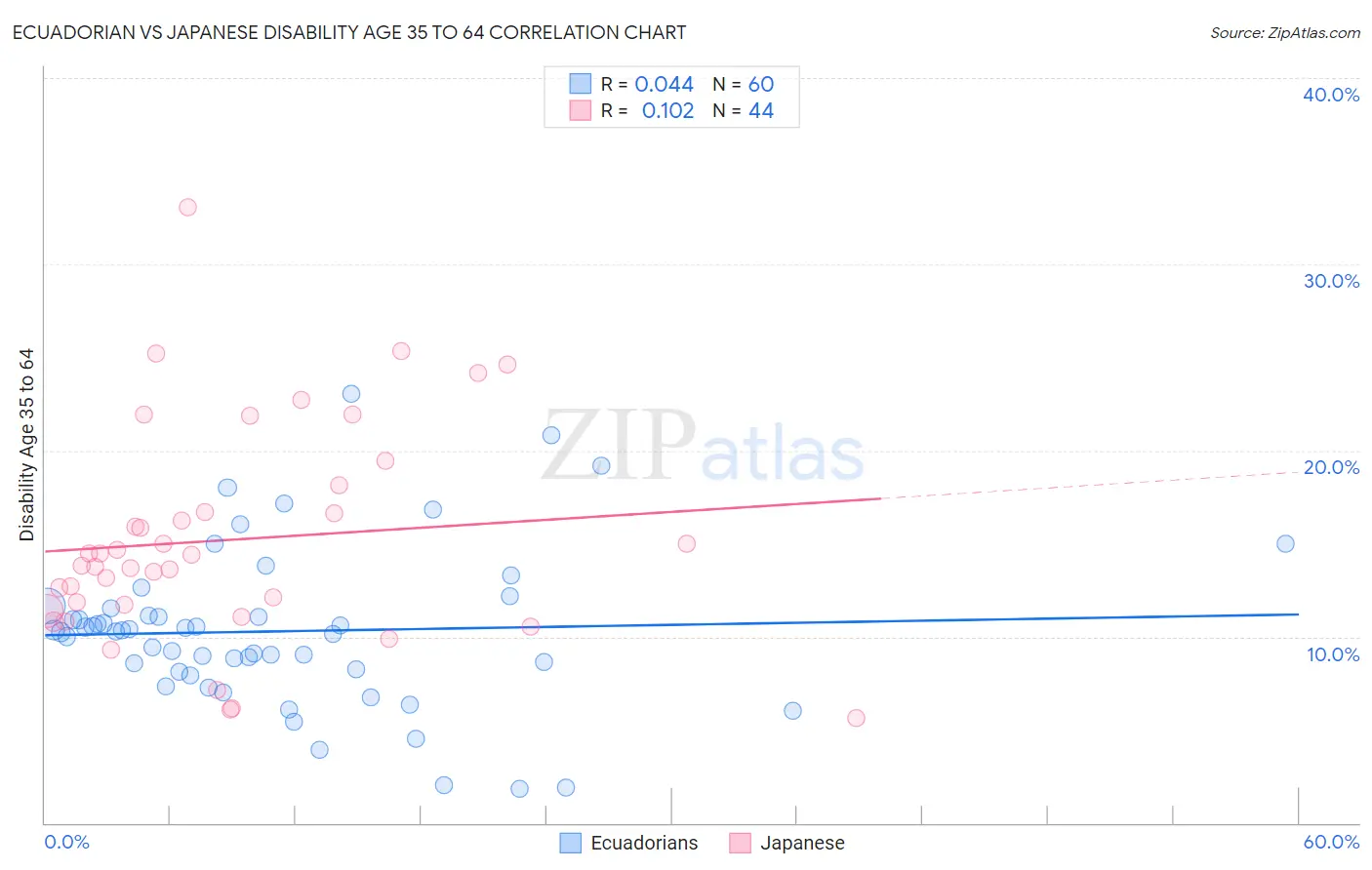Ecuadorian vs Japanese Disability Age 35 to 64
COMPARE
Ecuadorian
Japanese
Disability Age 35 to 64
Disability Age 35 to 64 Comparison
Ecuadorians
Japanese
10.7%
DISABILITY AGE 35 TO 64
93.1/ 100
METRIC RATING
129th/ 347
METRIC RANK
12.3%
DISABILITY AGE 35 TO 64
0.8/ 100
METRIC RATING
255th/ 347
METRIC RANK
Ecuadorian vs Japanese Disability Age 35 to 64 Correlation Chart
The statistical analysis conducted on geographies consisting of 317,605,985 people shows no correlation between the proportion of Ecuadorians and percentage of population with a disability between the ages 34 and 64 in the United States with a correlation coefficient (R) of 0.044 and weighted average of 10.7%. Similarly, the statistical analysis conducted on geographies consisting of 249,049,051 people shows a poor positive correlation between the proportion of Japanese and percentage of population with a disability between the ages 34 and 64 in the United States with a correlation coefficient (R) of 0.102 and weighted average of 12.3%, a difference of 15.6%.

Disability Age 35 to 64 Correlation Summary
| Measurement | Ecuadorian | Japanese |
| Minimum | 1.8% | 5.7% |
| Maximum | 23.1% | 33.0% |
| Range | 21.2% | 27.4% |
| Mean | 10.3% | 15.2% |
| Median | 10.3% | 14.1% |
| Interquartile 25% (IQ1) | 8.2% | 11.5% |
| Interquartile 75% (IQ3) | 11.3% | 17.4% |
| Interquartile Range (IQR) | 3.2% | 5.9% |
| Standard Deviation (Sample) | 4.2% | 5.8% |
| Standard Deviation (Population) | 4.2% | 5.7% |
Similar Demographics by Disability Age 35 to 64
Demographics Similar to Ecuadorians by Disability Age 35 to 64
In terms of disability age 35 to 64, the demographic groups most similar to Ecuadorians are Immigrants from Syria (10.7%, a difference of 0.020%), South African (10.7%, a difference of 0.080%), Immigrants from El Salvador (10.7%, a difference of 0.080%), Immigrants from Albania (10.7%, a difference of 0.18%), and Immigrants (10.7%, a difference of 0.19%).
| Demographics | Rating | Rank | Disability Age 35 to 64 |
| Immigrants | Norway | 95.0 /100 | #122 | Exceptional 10.6% |
| Maltese | 94.8 /100 | #123 | Exceptional 10.6% |
| Estonians | 94.5 /100 | #124 | Exceptional 10.6% |
| Albanians | 94.2 /100 | #125 | Exceptional 10.6% |
| Immigrants | Afghanistan | 94.1 /100 | #126 | Exceptional 10.6% |
| Immigrants | Zimbabwe | 94.0 /100 | #127 | Exceptional 10.6% |
| South Africans | 93.3 /100 | #128 | Exceptional 10.7% |
| Ecuadorians | 93.1 /100 | #129 | Exceptional 10.7% |
| Immigrants | Syria | 93.0 /100 | #130 | Exceptional 10.7% |
| Immigrants | El Salvador | 92.8 /100 | #131 | Exceptional 10.7% |
| Immigrants | Albania | 92.5 /100 | #132 | Exceptional 10.7% |
| Immigrants | Immigrants | 92.5 /100 | #133 | Exceptional 10.7% |
| Immigrants | Ecuador | 92.5 /100 | #134 | Exceptional 10.7% |
| Greeks | 92.3 /100 | #135 | Exceptional 10.7% |
| Salvadorans | 91.9 /100 | #136 | Exceptional 10.7% |
Demographics Similar to Japanese by Disability Age 35 to 64
In terms of disability age 35 to 64, the demographic groups most similar to Japanese are Hawaiian (12.3%, a difference of 0.13%), Scottish (12.4%, a difference of 0.17%), Dutch (12.3%, a difference of 0.25%), Irish (12.3%, a difference of 0.28%), and Mexican (12.4%, a difference of 0.42%).
| Demographics | Rating | Rank | Disability Age 35 to 64 |
| Spaniards | 1.3 /100 | #248 | Tragic 12.3% |
| Hispanics or Latinos | 1.3 /100 | #249 | Tragic 12.3% |
| Immigrants | Burma/Myanmar | 1.2 /100 | #250 | Tragic 12.3% |
| Germans | 1.1 /100 | #251 | Tragic 12.3% |
| Irish | 1.0 /100 | #252 | Tragic 12.3% |
| Dutch | 1.0 /100 | #253 | Tragic 12.3% |
| Hawaiians | 0.9 /100 | #254 | Tragic 12.3% |
| Japanese | 0.8 /100 | #255 | Tragic 12.3% |
| Scottish | 0.8 /100 | #256 | Tragic 12.4% |
| Mexicans | 0.7 /100 | #257 | Tragic 12.4% |
| Welsh | 0.6 /100 | #258 | Tragic 12.4% |
| English | 0.6 /100 | #259 | Tragic 12.4% |
| German Russians | 0.5 /100 | #260 | Tragic 12.5% |
| Malaysians | 0.5 /100 | #261 | Tragic 12.5% |
| Senegalese | 0.5 /100 | #262 | Tragic 12.5% |